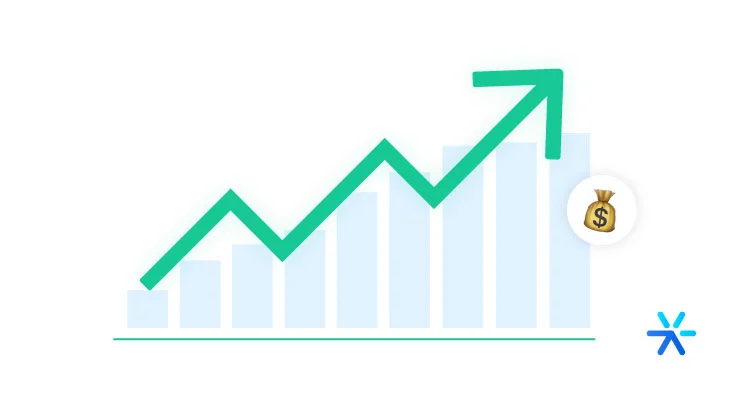ROI in Marketing: What It Is and How to Maximize Yours
Investing in marketing can seem complex with so many options and tools available today.
More than that, as important as creating and executing campaigns is understanding how they are bringing returns to your company.
Investments in digital marketing have provided an advantage when it comes to analysis and measurement.
Because the data is more complete, specific, and detailed, it’s easier to monitor how many people were impacted by the campaigns and what actual return each strategy generated.
Here on the blog, we’ve already covered other metrics like Customer Acquisition Cost and the Number of Qualified Leads.
In this article, we’ve prepared content to cover another key metric for the healthy development of your business and the success of your company’s marketing: ROI.
What is ROI in Marketing?
ROI stands for Return on Investment.
This is one of the most important metrics for any business and deserves your constant attention and monitoring.
That’s because ROI calculates how much money the company gains or loses with the investments it makes.
ROI is especially relevant when talking about marketing investments and the costs associated with strategies in this area.
It allows you and your team to have control over the results of campaigns, actions, and newly implemented marketing strategies.
How to Calculate the ROI of a Marketing Campaign?

To calculate ROI, you need a few data points:
First, determine the total revenue during the chosen period.
Then, sum up all marketing campaign investments made in that same period.
The ROI formula is:
ROI =
(Total Revenue – Marketing Investment) / Marketing Investment
For example, let’s say your company ran a six-month marketing campaign and wants to measure the marketing ROI for that period.
You spent a total of R$20,000 on marketing actions.
And the total revenue during this period was R$100,000. So:
ROI =
(100,000 – 20,000) / 20,000 = 4
In this example, the return on investment was four times, or 400%, in comparison to the initial investment.
Also, to properly calculate your marketing ROI, it’s not enough to plug numbers into a formula. You should also analyze it alongside other metrics that impact your business.
After all, not all marketing campaigns have sales or conversions as their final goal. That’s why looking only at the “money” certain actions generated may distort your view of the marketing process.
With that in mind, here are the 5 most commonly used digital marketing metrics to help you measure ROI:
Conversion Rate
Widely discussed in marketing, the conversion rate is one of the most-used metrics to track return on investment over time.
If your campaign goal is conversion, conversion metrics will tell you whether or not you are achieving it. Through this, you’ll know what’s working and where to allocate your resources for better results and higher ROI.
Within the conversion rate, you can analyze:
- Channel – Know where your traffic is coming from so you can invest more in high-return media.
- Device – Do your campaigns convert better on mobile or desktop? This is essential for optimizing investment and device usage.
The conversion rate can be calculated as:
Conversion Rate = (Total Conversions / Total Visitors or Leads or Opportunities) × 100
Want to benchmark your conversion rate? Check if it matches your industry standards in the 2024 Lead Generation Panorama!
CPL (Cost per Lead)
If your campaign goal is to capture new leads for your sales team to close, you’ll need to calculate your ROI alongside the Cost per Lead, i.e., how much you’re paying for each new lead.
The CPL formula is:
CPL = Marketing Investment / Number of Leads Captured
With this analysis, you can determine the return on investment for each lead generation campaign.
If you notice the cost per lead is higher than the acquisition strategy itself, it means you are not getting a positive return on investment.
Lead-to-Sale Rate
Beyond acquiring leads, it’s important to monitor which ones actually become customers.
That’s why tracking the lead-to-sale rate is crucial when evaluating the effectiveness of your marketing campaigns.
Compare this rate with the leads being generated to assess your profitability.
CPA (Cost per Acquisition)
CPA tells you the average cost to acquire a new customer.
It’s almost like ROI, but less detailed. It analyzes how much each new customer costs overall, regardless of their source.
Analyzing CPA alongside ROI is crucial to determine whether you’re spending more to acquire a customer than they’re actually worth to your business.
LTV (Lifetime Value)
Last but not least, LTV defines the total value a customer brings throughout their lifecycle.
It offers a long-term profit view, giving you a new perspective on acquisition costs and ROI.
To calculate LTV, use the formula:
LTV = Average Customer Ticket × Average Purchases per Year × Customer Relationship Lifespan
What Is a Good Marketing ROI?

The answer can vary — ROI depends on the company and the campaign.
But in general, a good marketing ROI brings a positive financial return to the company, meaning the profit from the campaign exceeds the investment.
Some businesses are satisfied with a 2:1 ROI (for every $1 invested, $2 are returned). Others aim for higher ratios like 5:1 or even 10:1.
On the other hand, a negative ROI means the campaign generated more costs than profits. Even a low ROI can be unsatisfactory — for instance, a 1.1:1 ROI may be technically profitable but may not justify the investment.
🔎 Read also: 20 Marketing Strategies for Startups Focused on Growth
What Is ROI For and Why Is It Important?
By calculating ROI, you can identify which investments have the highest return and which marketing campaigns were most successful.
🔎 Read also: Corporate Marketing: Where to Start? 5 Current Marketing Tips
It’s also relevant in several strategic aspects:
Team Morale
Good performance metrics boost team morale and motivation.
Marketing success reinforces the importance of the department and promotes a more stimulating work environment.
🔎 Read also: Why a Growth Head Is Essential for Any Company
Higher Profits
Paying attention to ROI means optimizing investments.
If your company’s money is going to the right places, your profit margins increase as a result.
Better Goal Setting
Analyzing past data and investments makes it easier to define realistic and aligned goals.
With clearer objectives, investment and effort distribution also improve.
Lower Costs
Measuring ROI also helps cut unnecessary expenses, makes you reassess major investments, and gives you more confidence when making decisions.
Long-Term Results
Tracking results based on ROI creates long-term changes in the company.
Teams develop a more analytical mindset, and work becomes increasingly results-oriented.
What Are the Limitations of ROI?
ROI in marketing is an excellent tracking metric, but it’s important to recognize some limitations and caveats when using it to evaluate the success of your strategies.
If you’d like, I can help turn this article into a formatted PDF or a slide deck.
The main one is that it’s not so simple to define a good benchmark for what is or isn’t a good return rate.
🔎Also read: What Is Performance Marketing, How to Use It, and 6 Examples
But there are still other limitations:
It Doesn’t Account for Inflation
ROI doesn’t consider value fluctuations due to inflation—whether increases or decreases.
Let’s say your company had a 10% marketing ROI.
With current inflation, most of that value would be eroded.
So, your actual return wouldn’t be 10%.
It Doesn’t Consider Seasonality
Another downside is that ROI doesn’t factor in seasonality, which is a major determinant for marketing and sales actions.
This is especially true in specific market segments like car sales or products tied to holidays—sales are driven by social and cultural patterns.
Failing to consider these seasonal variations can hide poor results in certain periods.

It Doesn’t Take Investment Duration into Account
The ROI formula doesn’t change whether the campaign lasted one week or the entire year.
Imagine a company invested heavily only in January and drastically cut spending afterward.
When calculating the annual ROI, that variation isn’t considered—it only uses total figures.
The Calculation Can Be Manipulated
You need to ensure everyone involved is aligned on how values are detailed when calculating marketing ROI.
Since it involves summing many elements to reach total revenue and investment values, a data entry error or misalignment can result in inaccurate numbers.
How to Maximize Your ROI

To improve your ROI, you need to optimize your investments.
With money allocated to the right strategies, your marketing spend generates more return, increasing your company’s ROI rate.
🔎Also read: Artificial Intelligence in Digital Marketing – 21 Use Cases
Here are some tips you can apply:
Set Clear Objectives
Before jumping into execution, take a step back and invest time in planning to improve your ROI.
Analyzing past data and investment history makes it easier to define your goals.
With clearer objectives, you’ll know how to distribute your investments and monitor whether the campaign is achieving its goals.
If things don’t go as planned, you can always review and adjust your strategies—another advantage of digital marketing!
Use CRO
CRO stands for Conversion Rate Optimization.
By applying CRO strategies, you can increase your conversion rates and improve investment results.
If your conversion rates are low, it means you’re spending money to attract people to your site, blog, or landing pages—but they’re not taking action.
That’s essentially a negative investment.
Conversational Marketing
A modern way to improve conversion rates is through Conversational Marketing tools.
Using chatbots and virtual assistants, you can engage page visitors in a personalized, dynamic way and boost your conversion rates by up to 3x.
It also helps generate better-qualified leads.
Understand Each Stage of the Prospect Journey
We mentioned qualified leads earlier—but what does that mean?
Offering your product or service upfront in a campaign isn’t always the best strategy.
Consumers are bombarded with offers all the time—and not all of them are ready to buy.
That’s where the “Buyer’s Journey” comes in.
From first contact to final purchase, consumers need to build trust and develop the need for your solution.
For companies, this means qualifying leads—turning contacts into increasingly engaged prospects until they become customers.
To improve your marketing ROI, understand the different stages of the journey.
That will help you better distribute your marketing actions and communicate with the consumer at each stage of buying maturity.
Segment Every Campaign
To reach consumers at different stages of the journey with the right communication and offer, segment your marketing campaigns.
Paid media platforms like Google Ads and Facebook Ads provide many segmentation options to target highly specific audiences.
Align the Campaign with its Goal
Think about the objectives you set in your initial planning. Then define what type of ad will be most effective for each stage of the buyer’s journey.
Do you want to attract new people?
Target users who’ve already interacted with your brand?
Send offers to returning customers?
Your ad creatives and investment distribution must align with the campaign’s specific objective.
Create Detailed Targeting
You can now segment campaigns based on individual user behavior and consumption data.
Use this data available in ad platforms.
Segment your campaigns by interest, consumption habits, demographics, age group, occupation, and more—there are many options to explore and test.
Use Email Lists
Did you know you can use your contact list to create segmented ads?
For example, if you want to target leads who requested a quote but didn’t convert, tools like Facebook Ads let you upload email lists and target users based on that data.
You can also do the opposite: exclude current leads from campaign targeting if you want to reach only new contacts.
Use Retargeting
Retargeting and remarketing are also excellent segmentation strategies.
They allow you to target users who have already visited your site, blog, or landing pages—and even segment by specific page visits.
The chance of grabbing the attention of someone who already interacted with your brand is much higher.
Nurture your Leads
Another way to manage the Buyer’s Journey stages is through lead nurturing.
Lead nurturing helps guide users along the journey, maintaining and increasing their interest in your brand and the solution you offer.
It also enables you to deliver content and offers tailored to their level of purchase readiness.
Here, marketing automation tools are essential to streamline these actions and interactions.
Start Small Until Validated
As mentioned earlier, one advantage of digital marketing is the ability to adjust campaigns while they’re still running.
In addition to tweaking investment levels, you can run tests, monitor performance, and reinvest in the most effective campaigns and channels.
Always base your decisions on data.
Create ROI Reports for Each Campaign
Instead of relying solely on data within each platform, consolidate everything into a detailed campaign-specific report.
This helps with real-time decision-making and creates a long-term historical record of your company’s marketing activities.
How to Create an ROI Report

For a comprehensive report, first decide whether you’ll also track other metrics besides marketing ROI, like Customer Acquisition Cost (CAC).
Also, identify the campaign, time period, objectives, spending, and results.
🧐 Learn more: Marketing Reports: How to Build One, Metrics + 3 Templates
Define the Audience
This refers not to the campaign audience, but to whom the report will be presented.
For example, a marketing analyst and a company’s CEO care about different data points.
So, understand your report’s audience and choose metrics based on that perspective.
Choose the Metrics
A good report doesn’t need to be lengthy or overloaded with data.
Focus on What Matters for your Srategy.
Based on the analysis of who will be reading the report, define the metrics according to what is most relevant to that audience.
Choose the Reporting Frequency
Also determine how often the report should be updated.
This needs to be very well aligned—especially if more than one team member will be responsible for updating the report.
Additionally, define how often the report will be presented to higher-level roles, such as management and executives.
Know How and Where to Extract Metrics From
Use the right tools to extract all data according to the channels and investments made.
The most suitable professionals to complete each metric are those closely monitoring the campaign’s daily performance. But it’s important to align with them on a guide so everyone knows how to access and extract the data.
Create a Template
The next step is to decide how the report will be presented.
Here, the most important thing is for it to be easy to interpret, visual, and fast.
And of course, simple to update.
Your marketing team’s time and effort should go into data analysis and strategy—not into filling out the report.
Conduct Analyses
Not all data will immediately deliver the most critical insights for the business.
That’s why the analysis section is fundamental in any report.
Some ways to present these analyses include:
- Action and reaction: what results were obtained directly from the actions taken, and what was lost due to actions that weren’t executed (such as in case of budget cuts);
- Correlation: what were the experiences and outcomes of each channel and campaign extension;
- Benchmarking: how your metrics compare to the market.
3 Marketing ROI Statistics
There’s no better way to understand ROI than by looking at statistics that reflect it in real marketing campaigns, right?
So, here are three statistics you can use as inspiration:
For every $1 spent on email marketing, companies get $40 ROI
According to a 2023 Smart Insights study, email marketing offers one of the highest returns on investment.
It reported a revenue return of $30 for every $1 spent—an exceptional figure.
Over 70% of companies attribute their success to tracking content marketing ROI
According to research by the Content Marketing Institute, 72% of the most successful companies calculate the ROI of their content marketing, compared to just 22% of the least successful companies.
This highlights how important it is to assess whether the content being produced is actually helping to grow the business.
Marketers who calculate their ROI are 1.6x more likely to receive higher budgets
According to a HubSpot report, marketers who measure ROI are more likely to be granted larger budgets by their companies.
In other words, it’s becoming increasingly necessary to be familiar with how to calculate your campaign’s return rates. That way, you can demonstrate marketing’s impact to your supervisors and managers—earning their trust and securing more funding.
Bonus: What Is SEO ROI?
To wrap up this complete article on ROI, let’s clarify what SEO ROI means:
SEO ROI stands for the return on investment in search engine optimization. It’s a metric used to evaluate the performance of a website optimization strategy aimed at improving rankings in organic search results.
You can calculate SEO ROI by dividing the value generated by SEO by the amount invested in it. The value generated may include an increase in organic traffic, higher conversions, more sales, and many other metrics (like the ones we’ve mentioned above) that contribute to business success.
Let’s look at an example:
If a company invests R$5,000 in SEO (outsourced team, tools, internal staff, etc.) and sees a R$10,000 increase in sales as a result, then the SEO ROI would be 100%.
R$10,000 – R$5,000 = R$5,000
R$5,000 / R$5,000 = 1
1 x 100% = 100%
It’s also important to note that SEO ROI may take time to show, as search engine optimization is a long-term strategy that requires ongoing investment and adjustments over time.
Ready to boost your profits and make smarter decisions by tracking your marketing ROI?
This metric has a profound impact on your company’s campaign success and your ability to build a strong analytical foundation.
Need help defining new metrics for your team but don’t know where to start? Download our OKR and KPI framework and make your management tasks easier. 😎








